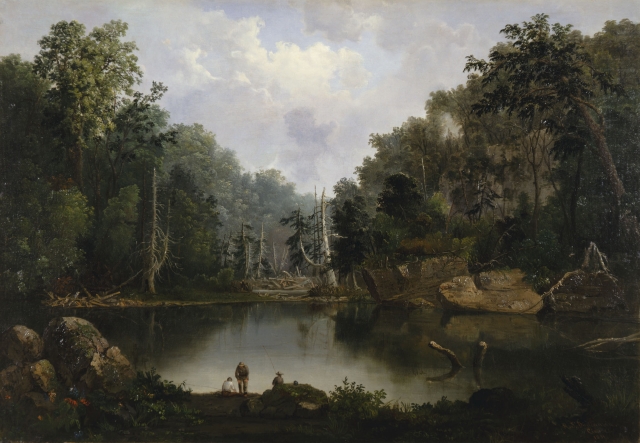Updated 030210: False Solomon’s Seal (Smilacina racemosa) blooms in the Glen beginning in mid-May. [Photo by a blind flaneur]
As a kid I learned to distinguish two flowers called Solomon’s seal, one identified as “True” and the other “False.” The flower perched above the leaves in the first, and below them in the second. The fruit of at least one of them was edible. I ate them, at any rate, and I didn’t get sick or see visions of Euell Gibbons.
Like most botanical knowledge acquired in my childhood, I feel certain of its identity when I’m in the woods, then begin to have doubts when I look it up at home. Wikipedia tells me there are more than 50 species in the genus Polygonatum. I wonder now whether this is one of them. I haven’t consulted my mother’s field guide to wildflowers, the reference I know the best.
I found these flowers in almost the same spot where I saw a trillium and startled an osprey earlier in the spring. There must be some enchantment here that guides my attention.
![gustave_caillebotte_paris_street_rainy_day Gustave Caillebotte. Paris Street, Rainy Day (La Place de l’Europe, temps de pluie). 1877. Oil on canvas. Art Institute of Chicago. [Source: Wikimedia Commons]](../../../../wp-content/uploads/2009/02/gustave_caillebotte_paris_street_rainy_day_1877_wiki.jpg)
 The legendary Kiki of Montparnasse posed for Man Ray’s
The legendary Kiki of Montparnasse posed for Man Ray’s 

![Fog at Isle Royale [Source: wildmengoneborneo.com] Fog at Isle Royale [Source: wildmengoneborneo.com]](../../../../wp-content/uploads/2008/04/isle_royale_fog.jpg)

 If there is an emerging genetic underclass, I could run for class president or class clown. Read more in
If there is an emerging genetic underclass, I could run for class president or class clown. Read more in 

Botanical.com provides this description of a European species, Polygonatum multiflorum (ALLEM.). I love its linguistic precision:
Well, I’m really having doubts now. Here is how Illinois Wildflowers describes a species native to eastern North America, Polygonatum commutatum:
You’ve brought a touch of Spring to yet another cold, snowy day in the mountains of N.C. Your photo shows False Solomon’s-Seal, Smilacina racemosa. It bears its flowers, spirea-like and creamy-white, in terminal clusters. The true Solomon’s-seals, Polygonatum biflorum, have their flowers in the leaf axils. The flowers are paired, greenish-yellow, and dangle beneath the leaves like little fairy bells. Both plants are native here. There’s also a colony of the Great Solomon’s-Seal, Polygonatum canaliculatum, which grow very tall. Deer have eaten them the past few years before they’ve had a chance to grow much.
Polygonatum commutatum, which you mention,or smooth Solomon’s Seal, is a var. of Polygonatum biflorum. I don’t know enough to elaborate on that.
Happy can’t-come-too-soon Spring!
Thanks for setting me straight, Betty. We are ten weeks away from Solomon’s seal here, and the ice and snow makes it feel even more distant. The most promising sign of spring I have is the cry of red-tailed hawks every morning. I hope they will nest here again this year.